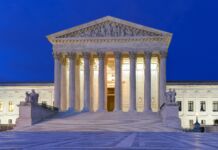
Here is the latest guidance from the Department of Labor (DOL) addressing the legislative impact of the Families First Coronavirus Response Act (FFCRA), which takes effect April 1, 2020. Of course, none of these interpretative pronouncements by the DOL are entitled to much deference (they’re not implementing regulations) but, given the speed with which things are happening, and given that April 1 is now 5 days – or approximately 103 hours – away, we wanted to share it with you.
The DOL’s guidance clarifies four important issues for employers
- If an employer’s worksite is closed or employees are on furlough (i.e., economic reasons cause employees to be out of work), the employees are not eligible for FFCRA benefits.
- To qualify for tax credits under the FFCRA, employers must keep detailed documentation.
- Employers maintain discretion to grant intermittent leave to employees (it’s entirely within the employer’s discretion).
- Employers may allow employees to use both FFCRA benefits and pre-existing benefits originally provided to an employee but cannot impose such an obligation on an employee.
Key topic areas covered in the DOL’s guidance on frequently asked questions
- How does a company review the requests for leave and get the tax credits under the FFCRA?
- Employees must provide appropriate documentation to support leave requests, including a qualifying reason for leave and statement that the employee is unable to work or telework for that reason, and the leave dates. See Question Nos. 15-16.
- Also, in order to receive tax credits under the FFCRA, employers must retain this documentation. See Question Nos. 15-16.
- What does it mean to “telework”?
- Telework is described as work for which normal wages must be paid and is not compensated under the paid leave provisions of the FFCRA. See Question Nos. 17-18.
- What does it mean to be “unable” to work or telework?
- An employee is unable to work if his or her employer has work available, but the employee is unable to do so because of one of the specified reasons for paid leave. Important Note: If the employee can telework while caring for a child, leave is not available.
- Can COVID Paid Sick Leave and COVID FMLA be taken intermittently?
- Yes, if the employer allows it and the employee is unable to telework his or her normal schedule of hours due to a qualifying reason. Intermittent increments are determined by agreement between employee and employer, except the time off must be taken in full day increments if the employee is not teleworking. See Question Nos. 20-21.
- Can employees get COVID Paid Sick Leave or COVID FMLA when the worksite has closed or the employee is furloughed?
- Work Closure: If an employer’s worksite closes before, on or after April 1, 2020, employees will not be entitled to COVID Paid Sick Leave or COVID FMLA because the employer does not have work for the employee.
- This is true whether the employer closes for lack of business or because it is required to close due to a federal, state or local directive. It is also true whether the employer tells the employee that it will reopen at some point in the future. Employees in this situation should apply for unemployment benefits. This also means that if an employee is already out on COVID Paid Sick Leave or COVID FMLA, the employer must pay for any paid sick leave or COVID FMLA for which an employee was eligible before the employer closed, but as of the date of the worksite closure, employees are no longer eligible for benefits.
- Furloughs: If an employee is furloughed on or after April 1, 2020, because the employer does not have enough work or business for the employee, the employee is not entitled to take COVID Paid Sick Leave or COVID FMLA.Employees in this situation should also apply for unemployment benefits.
- Is FFCRA available to an employee whose hours are reduced?
- No, if the employer reduces the schedule because it does not have work for the employee to perform. The employee may take COVID Paid Sick Leave or COVID FMLA if a COVID-19 qualifying reason prevents the employee from working his/her full schedule. In this case, the amount of leave is computed based on the employees’ work schedule before it was reduced. See Question Nos. 20-21.
- Can an employee get both unemployment and FFCRA benefits?
- Generally, no, but employees should contact state unemployment agencies for definitive answers because reduction in work hours may qualify and allow employees to get benefits. See Question No. 29.
- Must an employer maintain health insurance coverage while employees are receiving FFCRA benefits?
- Yes, and the employee must continue to make any normal contributions. If employees cannot return to work after the leaves expire, they must check with the employer as to whether they are eligible to keep health coverage on same terms. If they are not eligible, COBRA or applicable “mini-COBRAs” can be elected at that time. See Question No. 29.
- What is the interrelationship between the FFCRA benefits and pre-existing leave benefits that an employer might offer?
- An employee cannot take both FFCRA and pre-existing leave entitlements unless the employer permits the employee to supplement COVID Paid Sick Leave or COVID FMLA with any pre-existing leave. Further, an employer may not require that employees use pre-existing leave in addition to the FFCRA benefits. Employers can pay employees in excess of the FFCRA entitlement amounts, but will not be able to receive tax credits for such amounts. See Question Nos. 31-34.
Read the full version of the FAQs here:
https://www.dol.gov/agencies/whd/pandemic/ffcra-questions
View PDF




